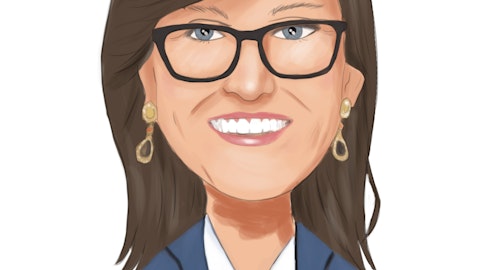Allot Ltd. (NASDAQ:ALLT) Q3 2023 Earnings Call Transcript November 22, 2023
Operator: Ladies and gentlemen, thank you for standing by. Welcome to Allot’s Third Quarter 2023 Results Conference Call. All participants are at present in listen-only mode. Following managements formal presentation, instructions will be given for the question-and-answer session. As a reminder, this conference is being recorded. You should have all received by now the company’s press release. If you have not received it, please contact Allot’s Investor Relations team at EK Global Investor Relations at 1-212-378-8040 or view it in the news section of the company’s website at www.allot.com. I would now like to hand over the call to Mr. Kenny Green of E.K. Global Investor Relations. Mr. Green, would you like to begin.
Kenny Green: Welcome to Allot’s third quarter 2023 conference call. I would like to welcome all of you to the conference call and I’d like to thank Allot’s management for hosting this call. With us on the line today are Mr. Erez Antebi, President and CEO; and Mr. Ziv Leitman, CFO. Erez will provide an opening statement and summarize the key highlights of the quarter. We will then open the call for the question-and-answer session and both Erez and Ziv will be available to answer those questions. You can also find the financial highlights and metrics, including those we discussed on the conference call, in the earnings release issued last week. Before we start, I’d like to point out the following safe harbor statements. This conference call contains projections or other forward-looking statements regarding future events or the future performance of the company.
These statements are only predictions and Allot cannot guarantee that they will in fact occur. Allot does not assume any obligation to update that information. Actual events or results may differ materially from those projected, including as a result of changing market trends, delays in the launch of services by customers, reduced demands and the competitive nature of the security services industry as well as other risks identified in the documents filed by the company with the Securities and Exchange Commission. And with that, I would now like to hand the call over to Erez. Erez, please go ahead.
Erez Antebi: Thank you, Kenny. I’d like to welcome all of you to our conference call. Thank you for joining us today. Our third quarter revenues were $22.6 million, 10% lower than the comparable quarter last year. In September 2023, our SECaaS ARR was $10.6 million, 9% higher than our SECaaS ARR in June 2023, and 52% higher than our SECaaS ARR for September 2022. 2023 continues to be very challenging for us. The transition of the business into SECaaS recurring revenue model has proved to be slower than we originally anticipated. In addition, our core DPI business is experiencing macro-related headwinds. While we don’t expect these challenges to disappear in the near-term, given the challenging economic backdrop, we continue to make progress with the aspects of the business that we can control.
During the third quarter, our cash balance fell by $5.5 million, mostly as a result of the operating loss and decrease in account payable. Cash burn continues to be a major area of focus for us. As our cost-cutting efforts come into effect partially in the fourth quarter and in full in 2024, we expect to improve our cash flow. While our visibility remains challenged, we remain committed to reaching profitability in 2024. Our gross margin in the second quarter was 48% due to our deal mix. We continue to target 70% gross margins for 2024, consistent with our historical performance. As we announced in July, given the challenges facing our business, the Board formed an executive committee that has worked with management to identify and recommend opportunities for further improvement with focus on driving sustainable profitability and enhancing shareholder value.

The executive committee and management continue to work together to prepare the budget and operating plan for 2024. As we discussed in the previous call, in order to conserve cash, reach break-even profitability in 2024, and ensure that we have staying power even as SECaaS takes longer to ramp up. We implemented a cost reduction plan towards the end of the third quarter. We reduced approximately 30% from our employee headcount, from the end of the third quarter of 2022 to the end of 2023, while also implementing other cost reductions. Our third quarter numbers include a one-time lift a cost of approximately $1.5 million. As you know, Allot operates in two business lines, Allot Smart and Allot Secure. On the Allot Smart front, while we continue to see growing interest globally from governments as they look to block illegal activities such as drug trafficking, child pornography, and terrorism.
Our CSP and enterprise businesses remain soft. While some of the weakness is due to cutbacks in spending, we also recognize the need to continue shifting our resources and focus to developing countries and governments as developed countries and enterprises embrace the cloud. On the Allot Secure front, while spending by CSPs remains challenging, our SECaaS revenues are growing steadily. While we are not seeing the pace of growth we had expected given a slower deployment, there are quite a few positives worth highlighting. I would like to start with the North American market. Verizon business has successfully launched their network native security service which incorporates Allot NetworkSecure. The launch is going well, the number of customers is growing, and we are discussing with Verizon several expansion opportunities to different customer segments.
While we cannot be assured of our success in adding additional customer segments, I believe Verizon is the largest signed SECaaS opportunity for Allot. Furthermore, as other CSPs see Verizon’s success, I believe some will follow suit. We are already getting enhanced interest from other operators to better understand what Verizon is doing and let how they might do the same. In APAC, we recently launched another SECaaS service in Tonga. As this is a small deal, we guaranteed the revenue for a lot regardless of penetration as per the revised direction we have previously explained. We remain excited about our SECaaS opportunities as operators continue to be interested in launching network-based security services, and we have a differentiated scalable solution for CSPs. Looking ahead, I want to summarize our expectations for 2023.
We expect SECaaS revenues for 2023 to be around $10.5 million to $11 million. We expect the SECaaS ARR for December 2023 to be between $12 million and $13 million, and our total ARR including support and maintenance to be between $51 million and $53 million. Regarding our total revenue, operating loss, and cash flow guidance, we are providing a wide range because of a specific large expansion deal we expect to close this year. We expect our total revenues for the full year 2023 to be between $89 million and $94 million. Non-GAAP operating loss to be between $42 million and $44 million, including the $14 million doubtful debt reserve and cash burn for the whole year to be between $31 million and $38 million. As I stated, we remain committed to reaching profitability in 2024.
We expect the fourth quarter revenues to be $20 million to $25 million. Our strategy remains the same. While we believe that our DPI business has limited growth potential and the lumpiness of the business makes it difficult to forecast over short time frames, we think we can maintain a stable level of revenues through new use cases and market share gains, and we are using DPI’s profitability and cash flow generation to invest in our SECaaS business because our SECaaS business is where we see significant future growth opportunities. While our SECaaS revenues are being recognized later than we would have liked and later than we expected, I remain convinced of the large potential of this business and I’m confident that it will grow significantly in the coming years.
I have full faith in our company, our team, and our products. And I believe the actions we are taking — the actions we are taking make our goals achievable. And now, I would like to open the call for questions-and-answers. And Ziv and myself will be available to take your questions. Operator?
See also Philippe Laffont Stock Portfolio: 10 Top Stock Picks and 20 Rich Countries with Best Debt to GDP Ratio.
Q&A Session
Follow Allot Ltd. (NASDAQ:ALLT)
Follow Allot Ltd. (NASDAQ:ALLT)
Operator: Thank you. Ladies and gentlemen, at this time, we will begin the question-and-answer session. [Operator Instructions] The first question is from Max Michaelis of Lake Street. Please go ahead. Max?
Max Michaelis: Sorry, I was on mute. That’s my fault. When we look at — my first question is, looking at our 2024, just with the visibility being fairly cloudy, I mean, are you comfortable that you guys will be able to guide kind of [indiscernible]? Thank you.
Erez Antebi: I’m sorry, can you repeat the — your last, really the last sentence? Are we comfortable we’re able to guide?
Max Michaelis: Yeah. Here — so just given visibility just kind of like something we’re seeing market [indiscernible] giving 2024 guide?
Erez Antebi: At this point, we’re not giving a 2024 guide. We will be giving guidance once we finish our AOP and budget for 2024 which will be towards the end of this year. In the next earnings call, I expect we’ll be able to provide guidance on ‘24. The challenge you stated is correct. The visibility is tough, and yet we are going to guide to the best of our ability and we’re going to focus very hard to turn the profitable in ‘24.
Max Michaelis: And then the next question here is just on gross margin, a little bit of a down-tick here in Q3, I think this adjusted gross margin is around 48%. What’s giving you guys confidence you there, you can get back up to that 70% level in Q4 and then into 2024? And then maybe go into what caused that down tick in Q3 (ph)?
Ziv Leitman: Hi, Max. As we said in our previous conference call, we were expecting around, gross margin around 50% this quarter. So 48% is in the same range. And the reason was few deals with a very low growth margin. As we explained, sometimes we decide to take deals with a very low gross margin when it’s a competitive replacement, when it’s a strategic deal for us, when we expect future expansion. And also bear in mind that we can get a larger deal, but the amount that we recognize in the first quarter is much lower than the total deal, because it includes also support and maintenance for future years. So we carried out the amount of support and maintenance, which will be recognized later at the higher margin. Now, until Q3, for the last many years, our gross margin was around 70%, also in the first half of 2023, and we do believe that in spite of the low gross margin in the second half of 2023, we will be able to come back to the 70% gross margin next year.
Max Michaelis: All right. Thanks for taking my questions.
Operator: The next question is from Nehal Chokshi of Northland Capital Markets. Please go ahead.
Nehal Chokshi: Yeah. Thank you. And Erez, good to hear that there are some [indiscernible]. It sounds like, given that you have limited visibility, the buildup of how your guiding has changed, A, is that correct, and B, if so, how has it changed?
Erez Antebi: I’m not sure I follow the question now, sorry. How?
Nehal Chokshi: Yeah. Let me try to clarify. So for example, in prior quarters, your guidance may consist of some sort of bottoms-up basis where you’re looking at your pipeline and assuming some sort of close rate. Going forward, have you changed that process or changed the parameters that you utilized that process?
Erez Antebi: No, I think we’re still building it bottom up from what we see. And we’re trying to accurately forecast what the results are going to be and we do that in a very detailed bottom up process that we do internally and follow up on basically weekly. And it’s true that over the past couple of years, our ability to forecast the probability and timing of closing deals has diminished, so our forecast has become less accurate, but the process itself has not changed. It’s simply become harder for us to narrow the numbers correctly.
Ziv Leitman: Nehal, please remember that in previous years, like two years ago, we had a much larger backlog. So it was easier to focus the quarterly revenues. Now when the backlog is much lower, we are dependent on the same quarter booking. So we have a challenge to focus the revenues. So I agree with accuracy.
Nehal Chokshi: That’s helpful. And just to be clear, I mean, given the commentary around limited visibility, are you using lower probabilities to compensate for that lower visibility and lower probabilities of closing [indiscernible]?
Erez Antebi: We believe that our forecast is realistic and achievable, but it’s not conservative and it’s not aggressive. We think it’s realistic and achievable.
Ziv Leitman: And to directly answer your question, then yes, we’re assuming lower probabilities on things because it’s become harder to forecast.
Nehal Chokshi: Okay. Thank you. And then, I think, you mentioned that you’re looking to drive profitability, and it sounds like the main driver of drive-out profitability’s to continue to right-size the OpEx portion of the overall business. And while most of your OpEx is commingled between the SECaaS and the DPI, is there some amount of minimal investment that you’re going to want to maintain strategically on the SECaaS portion?



